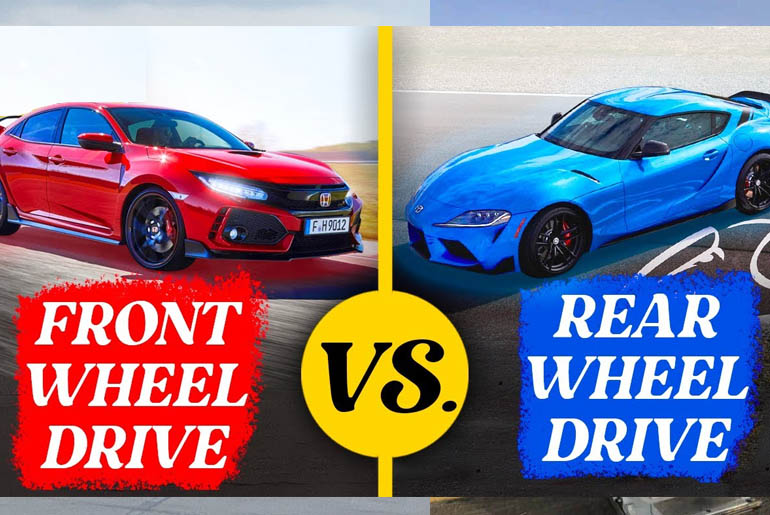When shopping for a vehicle, a critical issue is understanding which is higher for you: the front-wheel drive or the rear-wheel drive Knowing which is higher for you between a four-wheel force (FWD) and a rear-wheel force (RWD) may be a tough choice to make. This is due to the fact that each automobile has its own pros and cons, among different precise capabilities that cause them to stand out. Secondly, drivers have numerous alternatives and that determines which wheel force they have to buy.
Table of Contents
But with how choppy Nigerian roads are, it is quite tough to stick with one type. But if you are making a decision to buy an all-wheel drive, then you definitely have to have made up your mind to spend tens of hundreds of thousands of naira to accumulate one. Let’s see which one fits your needs better.
The front-wheel-drive works with a pulling mechanism much like a horse pulling a cart, even as the rear wheel force works with a pushing mechanism like a boy pushing a wheelbarrow. The speed, weight, capacity to move and braking gadgets will actually be different. Without seeking to have you ever crack your mind any further, we have determined to convey to you recommendations for understanding that are high-quality for you among FWD and RWD.
Front wheel drive
As the name implies, an FWD vehicle is one in which the front wheels perform the majority of the motion and manoeuvring while the rear wheels primarily serve as guide devices. This method means that the engine transmits strength to the front wheels in order that once they rotate, the burden of the automobile is pulled with the aid of the tires in the front even as the tires in the back truly act as a guide.
With how the FWD is built, there is absolutely no weight in the front due to the fact that the engine, additives, transmission, and different structures are all stuffed into the bonnet in the front. This makes the front compartment of the automobile heavier (remember the pony and cart instance said earlier). This additional weight in the front improves the traction of the front wheels as they circulate, preventing the vehicle from spinning out of control.
Front wheel force saves extra gasoline and is especially appropriate for mild visitors. Furthermore, the front wheel force motors have a tendency to be extra green because of the pulling mechanism they operate on. The pressure wanted to tug the automobile is not as great as one had to push-this is the torque. Due to how the automobile is made, there is sufficient space inside the passenger compartment and the boot. Therefore, FWD motors have a tendency to be much more inexpensive to fabricate and buy. But this additionally comes with a few disadvantages.
For instance, the additives jam-packed into one area make each movement and mechanism inside the vehicle a chunky complex. Though it is easy to find where a fault is coming from, one fault from one part of the automobile can easily and quickly have an effect on some other parts of the automobile. Controlling the automobile whilst it spins out of control can also be tough, possibly as it hardly ever does. As a result, it is no longer recommended to use an FWD for drifting or vehicle racing. When something goes wrong, it rarely ends well. But all in all, the automobile is likewise reasonably priced to maintain.
Rear wheel drive
From the call as well, you may glaringly infer that the strength and automobile motion are reliant majorly on the wheels in the back of the car. Sports cars, racers, and high-priced and comfortable supercars are simply a number of the types of cars you will locate in this selection. It works with a pushing mechanism. The torque comes from the rear and propels the car to an instant peak speed. Hence, the decision that RWDs are quicker than FWDs.
How it really works is that there may be an extended force shaft connecting the wheels at the rear with the engine. It acts as a medium via which transmission and strength are sent. So, to some extent, the burden of RWD vehicles is extremely balanced. But what it has in strength, it does not have in gasoline economy-and this is simply one disadvantage. Secondly, the RWD is highly-priced and tough to preserve due to how complicated the complete working machine is. However, you may also end up with tires that are difficult to put on and take off. This is due to the fact that nearly an equal quantity of strain and friction take place on the rear and the front. Rear wheel force is typically geared up in race cars and comfort cars.
Conclusion
Choose front-wheel drive if you’re looking for a low-cost or low-finance vehicle to save money on gas. There are pretty some of them-just like the Toyota Camry, Honda Accord, and Mercedes Benz made in the early 2000s, a few BMWs, and so on. They’re no longer the most reasonably priced, but they might not price you a lot to preserve. In fact, in Nigeria, most mechanics found a way to restore cars’ use of FWD. So it’ll be easy to locate a dependable mechanic or even spare components while there are issues. You additionally get the gasoline economy.
On the other hand, if you are trying to find pace and automobile stability even as you drive, look to the rear wheel force. You also get better control and fewer chances for your tires to wear out quickly. If you revel in drifting and racing and do not mind spending extra on maintenance, the RWD is not a terrible idea. Whichever option you choose between front-wheel force and rear-wheel force.







